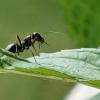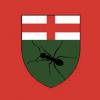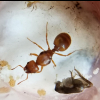Lexington, Kentucky – 07/19/2020
- Queen captured within Lexington, KY just outside of the University of Kentucky
- Collected 07/19/2020 at around 2:00 PM
- Downtown area, no bodies of water nearby, just outside UK campus. Grassy areas and bunches of trees are plenty.
- Length: 11.5 mm
- Dark brown to a red. The gaster seems almost striped with yellow because of the physogastric appearance.
I know this has to be a Formica queen but I have no idea what species this would be. Here are the pics. I don't know if this queen is just a member of the pallidefulva group who is physogastric or if it is a species that normally appears this way.



















